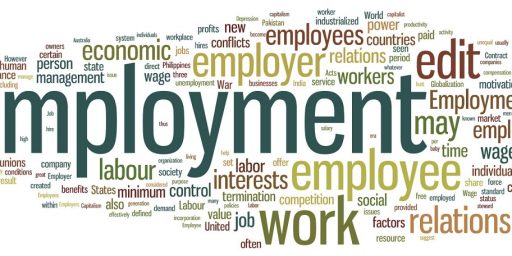America’s Jobs Crisis
Everyone's talking about jobs again. And it's not a pretty picture.
Whether it’s Occupy Wall Street, the heating up of the 2012 presidential campaign, or the continuing bad economic numbers, suddenly everyone’s talking about jobs again. And it’s not a pretty picture.
Barry C. Lynn and Phillip Longman ask, “Who Broke America’s Jobs Machine?” Alas, the question is based on a rather dubious premise:
If any single number captures the state of the American economy over the last decade, it is zero. That was the net gain in jobs between 1999 and 2009—nada, nil, zip. By painful contrast, from the 1940s through the 1990s, recessions came and went, but no decade ended without at least a 20 percent increase in the number of jobs.
The rather obvious flaw in this is that they begin with a peak year–the point right before the tech bubble burst–and end with the worst year in decades–right as the real estate bubble burst and the global financial crisis was in full bloom. Still, they point out something interesting:
[R]ecent Labor Department statistics show that the loss of jobs here at home, be it the result of sudden economic crashes or technological progress or trade liberalization, does not appear to be our main problem at all. Though few people realize it, the rate of job destruction in the private sector is now 20 percent lower than it was in the late ’90s, when managers at America’s corporations embraced outsourcing and downsizing with an often manic intensity. Rather, the lack of net job growth over the last decade is due mainly to the creation of fewer new jobs. As recent Labor Department statistics show, even during the peak years of the housing boom, job creation by existing businesses was 14 percent lower than it was in the late ’90s.
Their explanation for this, while not supported by any evidence, is at least plausible:
[W]hile the mystery of what killed the great American jobs machine has yielded no shortage of debatable answers, one of the more compelling potential explanations has been conspicuously absent from the national conversation: monopolization. The word itself feels anachronistic, a relic from the age of the Rockefellers and Carnegies. But the fact that the term has faded from our daily discourse doesn’t mean the thing itself has vanished—in fact, the opposite is true. In nearly every sector of our economy, far fewer firms control far greater shares of their markets than they did a generation ago.
Indeed, in the years after officials in the Reagan administration radically altered how our government enforces our antimonopoly laws, the American economy underwent a truly revolutionary restructuring. Four great waves of mergers and acquisitions—in the mid-1980s, early ’90s, late ’90s, and between 2003 and 2007—transformed America’s industrial landscape at least as much as globalization. Over the same two decades, meanwhile, the spread of mega-retailers like Wal-Mart and Home Depot and agricultural behemoths like Smithfield and Tyson’s resulted in a more piecemeal approach to consolidation, through the destruction or displacement of countless independent family-owned businesses.
It is now widely accepted among scholars that small businesses are responsible for most of the net job creation in the United States. It is also widely agreed that small businesses tend to be more inventive, producing more patents per employee, for example, than do larger firms. Less well established is what role concentration plays in suppressing new business formation and the expansion of existing businesses, along with the jobs and innovation that go with such growth. Evidence is growing, however, that the radical, wide-ranging consolidation of recent years has reduced job creation at both big and small firms simultaneously. At one extreme, ever more dominant Goliaths increasingly lack any real incentive to create new jobs; after all, many can increase their earnings merely by using their power to charge customers more or pay suppliers less. At the other extreme, the people who run our small enterprises enjoy fewer opportunities than in the past to grow their businesses. The Goliaths of today are so big and so adept at protecting their turf that they leave few niches open to exploit.
After a lengthy discussion of how a handful of holding companies dominate industries from breakfast cereal and toothpaste to department stores and automotive suppliers, they explain why the trend has harmed job creation:
As behemoth retailers garner ever more power over the sale of some product or service, they also gain an ever greater ability to strip away the profits that once would have made their way into the hands of their suppliers. The money that the managers and workers at these smaller companies would have used to expand their business, or upgrade their machinery and skills, is instead transferred to the bottom lines of dominant retailers and traders and thence to shareholders. Or it may be simply destroyed through pricing wars. A good example is the pre-Christmas book battle between Amazon and Wal-Mart, in which the two giant conglomerates pushed down the prices of hardcover best sellers to lure buyers into their stores and Web sites. In many cases, the two companies actually sold the books for less than they bought them, treating them as “loss leaders” and expecting to recoup the loss through the sale of other, more expensive products. Although consumers welcomed the opportunity to pay $9.99 for the latest Stephen King novel priced elsewhere above $30, the move caused a near panic among publishers. Even though the low prices may have resulted in the sale of more books, the longer-term effect is to radically lower what consumers will expect to pay for books, which will in turn reduce the funds available to publishers to develop and edit future prospects.
This is, interestingly, the opposite of what we would expect. Traditionally, the great fear of consolidation is that monopolies will be used to raise prices, since consumers lack ready substitutes. But Lynn and Longman point to the problem of a race to the bottom in pricing: cutting out the middle man means that the middle man no longer has a job.
Another way that monopolization can inhibit the creation of new jobs is the practice of entrenched corporations using their power to buy up, and sometimes stash away, new technologies, rather than building them themselves. Prior to the 1980s, if a company wanted to enter a new area of business, it would typically have had to open a new division, hire talent, and invest in R&D in order to compete with existing companies in that area. Now it can simply buy them. There is a whole business model based on this idea, sometimes called “innovation through acquisition.” The model is often associated with the Internet technology company Cisco, which, starting in the early ’90s and continuing apace afterward, gobbled up more than 100 smaller companies. Other tech titans, including Oracle, have in recent years adopted much the same basic approach. Even Google, many people’s notion of an enlightened, innovative corporate Goliath, has acquired many of its game-changing technologies—such as Google Earth, Google Analytics, and Google Docs—from smaller start-ups that Google bought out. As the falloff in IPOs over the last decade seems to confirm, one practical result of all this is that fewer and fewer entrepreneurs at start-up companies even attempt any longer to build their firms into ventures able to produce not merely new products but new jobs and new competition into established companies. Instead, increasingly their goal, once they have proven that a viable business can be built around a particular technology, is simply to sell out to one of the behemoths.
Again, this isn’t obviously a bad thing. Mark Cuban, for example, is positively giddy about it. And consumers generally benefit from the trend: Google identifies the best innovations and wraps them into their service–which they then give away for free. While I have my frustrations with Google’s power in the marketplace, I mostly surrender to it because they provide an incredibly valuable service that has made my life better. But, again, this efficiency comes at a cost: rather than dozens or hundreds of niche companies, each with their own management, employees, and logistics tail we now have one. And that means a lot fewer jobs.
Meanwhile, Nobel economics laureate Michael Spence describes what he terms “The Global Jobs Challenge.”
These massive structural changes in the global economy present three great employment challenges worldwide, with different countries facing their own variants.
The first challenge is to generate enough jobs to accommodate the inflow of new entrants into the labor market. Clearly, a wide range of advanced and developing countries is failing to do so. Youth unemployment is high and rising. Even in fast-growth developing countries, surplus labor is awaiting inclusion in the modern economy, and the pressure is on to sustain job creation.
The second challenge is to match skills and capabilities to the supply of jobs – an adjustment that takes time. It is also a moving target. Globalization and major labor-saving technologies have thrown labor markets in many countries into disequilibrium. Skills mismatches abound. Moreover, with continuing rapid growth in developing countries, the global economy’s structure is far from static, and it seems clear that the pace of market adjustment is lagging that of structural change.
The third challenge is distributional. As the tradable part of the global economy (goods and services that can be produced in one country and consumed in another) expands, competition for economic activity and jobs broadens. That affects the price of labor and the range of employment opportunities within all globally integrated economies. Subsets of the population gain, and others lose, certainly relative to expectations – and often absolutely.
Many advanced countries – in fact, most of them – have experienced limited middle-income growth. In some European countries, where income inequality has remained in check, this has been a component of a deliberate strategy to maintain employment growth and competitiveness in the tradable part of the economy, with wage restraint partly shared across the income distribution. In the United States, income inequality has risen as the upper end of the income and education spectrum benefits from globalization, while the rest experience declining employment opportunities in the tradable sector.
He subscribes to the “new normal” thesis best exemplified by Carmen Reihart and Kenneth Rogoff’s This Time is Different, which he cites approvingly.
Above all, it means that expectations are broadly inconsistent with reality, and need to adjust, in some cases downward. But distributional effects need to be taken seriously and addressed. The burden of weak or non-existent recoveries should not be borne by the unemployed, including the young. In the interest of social cohesion, market outcomes need to be modified to create a more even distribution of incomes and benefits, both now and in inter-temporal terms. After all, underinvestment now implies diminished opportunity in the future.
The imperative of structural adjustment also implies that individuals, governments, and other institutions (especially schools) need to focus on increasing the speed of adjustment to meet rapidly shifting market conditions. Attention to both the demand and supply sides of job markets is required. This means not only matching skills to jobs, but also expanding the range of jobs to match skills.
Finally, global economic-management institutions need to address whether the pace of globalization, and its implied structural change, is faster than the capacity of individuals, economies, and societies to adjust can withstand. If so, the next challenge will be to find non-destructive ways to moderate the pace in order to bring capacity to adjust and the need for adjustment into closer alignment.
Steven Rattner, who headed up President Obama’s Auto Task Force begins with a similar premise and says “Let’s Admit It: Globalization Has Losers.”
A typical General Motors worker costs the company about $56 per hour, which includes benefits. In Mexico, a worker costs the company $7 per hour; in China, $4.50 an hour, and in India, $1 per hour. While G.M. doesn’t (yet) achieve United States-level productivity in China and India, its Mexican plants are today at least as efficient as those in the United States.
G.M. has responded with inarguable logic. While reducing its United States hourly work force to 50,000 from 89,000 over the past five years, its Mexican hourly head count has risen, to 9,235 from 9,073.
[…]
So let’s start by acknowledging that just as occurred decades ago with agriculture, the declining role in our economy of manufacturing, which over the last half-century is down from 32 percent of the work force to 9 percent, will continue. Let’s also recognize that retreating into protectionism would turn a win-lose into a lose-lose.
And even if organized labor could force wage rates back up, that would hardly help domestic manufacturing compete against lower-cost imports.
Instead, we should follow the example of successful high-wage exporters in concentrating on products where we have an advantage, as Germany has done with products like sophisticated machine tools.
While America still leads in sectors like defense and aviation, our greatest strength, and a source of high-paying jobs, lies in service industries with high intellectual content, like education, entertainment, digital media, and yes, even financial services. Facebook, Google and Microsoft are all American creations, as are the global credit card companies American Express, Visa and MasterCard.
While that sounds great, I’m not at all convinced that the sort of people who’ve lost decent paying jobs as factory workers, forklift operators, or even middle managers are likely to be suitable for jobs in the technology or financial services sectors. Moreover, the same logic that sends auto manufacturing jobs to Mexico will naturally send an increasing number of technology jobs to India.
None of this is very encouraging and, to the extent that government can help alleviate the problem, I’m not convinced that either of the major parties has the answers.
The time-honored Republican solutions of lowering taxes and eliminating regulations has, to the extent it’s been helpful, run its course–the Laffer Curve curves and one can only deregulate so much. Further, it’s undeniable that, whatever gains these policies have had in terms of competitiveness and incentive for entrepreneurship, they’ve also contributed to the inequality and consolidation problems.
The Democrats, meanwhile, are mostly talking about make-work jobs–which may or may not be useful right now, but don’t address the structural issues at the heart of the matter–and banging the “education” drum. But the fact that those with advanced degrees have, on the whole, done better in this economy than those without doesn’t mean that we can fix everything by sending more people to school. For one thing, education is often simply a means of sorting by intelligence; people in the lowest quartile, and perhaps the bottom two quartiles, are unlikely to much benefit from the process. For another, education is a means of allocating existing jobs in certain high-income professions and occupations. Simply creating more lawyers and engineers doesn’t necessarily create more legal and engineering jobs.
My strong sense is that this will shake out in the end and that this “new normal” is not a permanent thing. But I’m only basing that on the fact that, thus far, that’s how things have always played out. Alas, trends continue until they don’t. If Reihart and Rogoff’ are right, we’re pretty much screwed.







There will not be demand for products and services until people have enough money to spend. With the increasing food prices and the high gas prices, that will not happen. We are just trying to put food on the table and get back and forth to work. That costs enough. Perhaps the bailout should have started with the working people: higher tax cuts or pay off credit cards/loans. Where did the 3 trillion dollars go? How many jobs were created? Why is BOA still laying off workers if they received TARP money? I want to see where every penny went. How can I do that?
I think they are using the correct economic reference.
When you have a history of saw-tooth growth then knowing where you are relative to previous peak does tell you exactly where you are. It could be worse. If previous peak was not the all-time high, you’d have to look back even further.
They might be wrong here though:
They choose “job creation” rather than long term jobs though, so it is possible that they are right about “churn.” As recent articles have reminded us, most Americans actually work for large firms, though at small “establishments.” (Establishments are what we used to call “rooftops” in our database design. A better word than “location.”)
Through much of their piece Lynn and Longman tangle monopoly with efficiency:
You can cherry-pick loss leaders or you can consider the larger picture of a grinding commitment to lower costs throughout their system, including labor costs but not limited to them. Walmart would be an example of higher labor productivity translating into fewer and lower paid jobs.
I think the Spence piece is much better, and agree with this:
There are some things we can to to break calcification in our economy (better intellectual property and health care solutions), but we will also need to accept long term unemployment … without writing it all off as lazy arts majors.
I agree also that while Rattner started with a good analysis, he ended with a weak prescription.
@Racehorse:
CNNMoney.com’s bailout tracker gives a high-level view.
Oh, I forgot the link to:
How Many Jobs Do Small Employers Create?
It explains the confusion between “small business” and “small establishments”
Overall, I think we have to get our ducks in a row, and then hope for the best.
– stop the wars
– fix the budget with something like a 1:3 tax increase to spending cut ratio
– slash education costs through aggressive adaption of technology
– break intellectual property bottlenecks
– use universal health care to create a more dynamic workforce
and possibly reinvent assistance for the poor. Will we need pubic housing again? Or can we afford all the programs that keep the poor in rentals?
We should also reconsider tariffs. They are good as a government revenue source even at levels far below “protectionism.”
The last time I looked it up, I think I came up with a net-average tariff of 2.5% on currently imported goods. I’d look at something like 3-5% as an improvement, as a source of revenue to pay benefits to displaced workers, etc.
The sad thing is that 3-5% is never really discussed in national discourse. We have the dichotomy of “free trade” or “protectionism” locked into our consciousness.
(I really hope no idiot pops up to claim that 5% is “protectionism.”)
“Instead, we should follow the example of successful high-wage exporters in concentrating on products where we have an advantage, as Germany has done with products like sophisticated machine tools.”
I’d bet a hundred bucks that Germany’s “advantage” is the product of policies that would be condemned as protectionist or anti-capitalist if they were suggested over here.
Mike
With the increased regulation, you have to be big or you can’t survive. That leads to their monopolization. Yes, there are also the efficiency of scale, etc. But take the lead in toys problem. Mattel imported poison toys, there was a scandal. Congress passed a law mandating testing of all children’s products, old and new. This is a trivial cost to Mattel who can amortize the testing lab cost over their large product line. However, their small competitors were forced out of the industry and you need a lot more capital before you can start a business dealing in children’s products. No more, hobbies growing until you need to hire help.
I have a friend who works for one of the top chemical companies. Their US plants are working full out to feed the global demand. They are building plants in China and India. But even if they wanted to build more US capacity, the ever changing EPA regulations and interpretations make it economically risky to the point of being unfeasible. If the need arises, they can import the chemicals from their overseas plants easier than they can build a plant here. That doesn’t mean do away with the regulations but we should stabilize them and change them in a manner in which businesses can adapt.
We should also look at the war against the skilled trades. It’s been 40 years of relentless work by the “educators” to label going into the skilled trades as a failed position. We didn’t suffer much until recently as the excess skilled tradesmen displaced by the manufacturing realignment in the 1980s provided abundant workers, many who started their own companies. Well, those workers/owners are retiring and the market for skilled tradesmen is feeling the impact of lack of supply. This is causing even more jobs to leave or automate as they seek machinists, welders, etc. in countries that still value the manual arts.
But don’t worry about the deficit of workers with useful knowledge, we have a plethora of poets, literary theorists and students of gender studies. Who it turns out have no more useful skills than the average high school dropout but a profound sense of entitlement that is sure to disrupt the workplace with their unhappiness at their “under-employment.”
@JKB: I see a two-fer in JKB’s dream future: If we strip away all the regulations, not only will businesses be free to pollute the air and water and sell poisoned food and deadly toys, but many of those poets and others he loathes because they aren’t manly engineers like him will die from the effects. Libertarian heaven!
Back in the 50s, 60s, 70s, etc, wealthy folk made more money by investing in industry – building plants, hiring people, and producing goods. That’s not what happens anymore. Ever since the Reagan era, all of the protections that were put into place after the Great Depression have been systematically and deliberately pulled down, especially thanks to the Congresses of the 90s. Ever since then, the wealthiest of the wealthy stopped making money by making _things_. Now they make money by trading pieces of paper around amongst themselves, and telling everyone else those papers are worth more, and more, and more. That’s what happened with CDOs. That’s what happens when banks, and mortgage companies, and hedge funds, and ratings agencies are all allowed to play with each other with no regulation and no oversight – they become literal parasites on the economy, drawing money out, but putting nothing back in. That’s why everyone else has been getting poorer. That’s what OWS is protesting. That’s what’s driving the backlash against the wealthy class.
I think focusing on growing inflation-adjusted income is probably the wrong way of dealing with this issue. One of the reasons why wages are so high in the Developed World is because the supply of potential labor and competitors was constrained due to trade and technological barriers. Create a situation where much larger part of the world can do the same tasks as the Developed World for lower labor costs, and you’re going to get declining wages in the Developed World down to the point where the greater productivity plus other costs of production make it more economically sensible to do things at Developed Nation wage levels.
Instead, we really ought to be focusing on getting Living Expenses down, particularly when it comes to housing. If my income stays stagnant, but my living expenses go down by 30%, I’m much richer without a single pay-raise.
@JKB:
That is an absolute, bald-faced lie. First of all, recent studies have shown that gov’t regs (in general) do _not_ put onerous pressure on businesses, large or small. Second, many times it’s the larger businesses themselves that lobby to get particular regs put in place, specifically to raise barriers to entry against competitors & smaller startups – _big_ business is _bad_ for business. You’re full of crap.
I don’t think the job market is as bad as the Republicans are trying to make it out to be.
Gallup has unemployment slowly declining since March:
http://www.gallup.com/poll/125639/Gallup-Daily-Workforce.aspx
Fixed that 🙂
@WR:
Yes, WR, any consideration of the regulations cost/benefit means that all regulations will be wiped away. Could you be more ignorant or foolish. If we decide to keep a regulation after careful consideration of its cost, then so be it. But that means you should stop whining about the lack of jobs caused by that regulation.
We will have the employment permitted by our policies and regulations and those in excess of that amount are SOL. If that means a stationary economy, then that is what we’ll have. Although, a stationary economy usually means a declining standard of living.
Either we loosen the grip of government from the throat of enterprise to permit innovation and entrepreneurship or we wallow around on Wall Street asking “Please Sir, can I have some more?”
@legion:
There are studies by ivory tower academics and there are those trying to keep their businesses above water and some hiring. I’ll go with the latter. And the business owners, who will speak even at the threat of the march of the inspectors, will tell you regulation is making it impossible for them to make a living. But no matter.
Your second point confirms mine. The existing, especially large, businesses use their crony contacts to make entry of competitors difficult and costly thus avoiding capitalism and free enterprise which would benefit consumers.
Here, let Milton Friedman explain it.
@JKB: “And the business owners, who will speak even at the threat of the march of the inspectors, will tell you regulation is making it impossible for them to make a living.”
Business owners ALWAYS complain about regulation the same way criminals ALWAYS complain about cops. Yes, if companies were just allowed to do anything they want, they might make more money for themselves at the expense of everyone else in the short run. In the same sense, I might have a lot of fun going on a meth-fueled rampage of murder and rape until the cops shoot me in the head.
Mike
@JKB:
In reality, business owners say low demand is the problem.
@JKB: “It’s been 40 years of relentless work by the “educators” to label going into the skilled trades as a failed position.”
Bullshit. I’ve been around during this period, and I don’t remember seeing any of this stuff.
The odd thing about the regulations is all of a sudden they are killing businesses, right at the time the economy isn’t doing well and the GOP needs a distraction. If you look at the regulations the GOP doesn’t like, it seems like even more of a meaningless stunt.
@David M:
Well, yes, that is how it happens. When business is good, the business can survive bad regulation, bad management, bad investments, bad employees. When things get tight, then there is no more excess to cover the bad things.
It is the way of life, when things are good, you can cover a multitude of sins but once things go bad, you find the virtues of clean living.
Just like the federal, state and local governments had no problem with all the obligations they were taking on when things were good but now that revenues have dried up and the economy is suffering, those entitlements loom large over everything.
@JKB:
I think the shorter explanation is that you can always complain about regulation.
A new “third” to death and taxes?
@JKB:
FIFY
As far as the regulations go, it doesn’t appear the GOP is targeting them for anything other than political reasons. You mentioned how the toy testing for lead paint is keeping new businesses from starting…seems to be a good opportunity to make it easier for domestic manufacturers rather than scrap the whole thing.
@JKB:
So how’s their chemical plant in Bhopal, India doin’?
Too bad we don’t have one of those right here in the USof A!
Actually, regulations and business are NOT mutually antagonistic.
Consider that businesses themselves are consumers, not much different than you and I.
For example- real estate investors rely upon, and make money from, building codes. If you are considering investing in two different buildings, in an unregulated world, how would an investor know which was a firetrap ready to collapse, and which was a secure well built structure? Engineering flaws are usually invisible, hidden under the plaster.
So building codes, engineering licensure requirements, and why yes, even corporate security laws all help investors by reducing risk.
The “freedom” to peddle tainted meat, shoddy buildings and mysterious junk bond level securities doesn’t benefit the nations business community one bit.
It is not regulations per say: it is regulation overkill, picky rules, and “fees” (=taxes) that are driving people crazy. In some cities of California, it takes over 100 pieces of paper – inspections, permits, licenses, etc. to open a restaurant. This is piling on to the extreme. Some is necessary but 70% is political. The people at city hall have to justify their (and their relatives) jobs. Talk to a construction contractor: they will tell you the same thing. It also is not just the Federal – it is state and local government too.
Likewise, when it comes to environmental regs:
There is a cost to rolling back environmental regs. Pollution doesn’t just disappear if you don’t combat it. It goes into the environment and, eventually, you suffer the consequences.
Take, for instance, underground storage tanks. Requiring that they be double-walled, have spill buckets, have capture systems of some kind for spillage, vapor recovery, etc. no doubt ads to the cost of buying and installing said USTs.
You know what else those regs do? They cut down on the amount of fuel that is lost to leaks, and of course that reduces the number of costly cleanups you have to do.
The idea that if the EPA (and/or the state-level equivalents) would just SHUT UP everything would be fine is a sick joke.
@Rick Almeida:
Gibson Guitar doesn’t have a lack a demand. They have a problem with the Justice Department selectively enforcing the Lacey Act, even when the Indian government, which is where the wood for the guitars came from, saying the wood purchase was legal. Now Gibson is threatening to close down operations here in the states and go overseas, taking a bunch of jobs with them.
Sometimes, stupid regulations really do hurt businesses.
@Moderate Mom:
Except Gibson Guitar isn’t the only company importing those types of woods, they are just the only ones who won’t follow the regulations.
@Moderate Mom:
A law that forbids US companies from buying resources obtained illegally in other countries is stupid?
@Racehorse: Eh, I am an architect, so I know me some construction regulations.
@Rob in CT:
Apropos of your comment re: EPA regulations of underground tanks;
Our client, a large real estate development firm, is stalled on a multimillion dollar housing project.
Why?
Because in previous decades, the past owners of the property had shoddy, leaking gas tanks that contaminated the soil, which had to be cleaned up. There isn’t much of a marketplace for houses built on ground oozing toxic petroleum vapor.
The previous owners might have saved, oh, a few thousand dollars on non-EPA regulated tanks. Now that carelessness is costing maybe a few million to clean up, and carry costs.
Its interesting how conservatives love to rail against the straw man of “regulation”, yet can never point to one that really is “overkill” and “unnecessary.”
All economic crises can ultimately be traced to insufficient demand from the masses. The inability of our establishment to accept this fundamental principle has resulted in four years of misery for tens of millions. We’re told job creation is difficult to justify total inaction; in reality creating jobs is quite easy, all that is required is stimulaion of aggregate demand and the markets will do the rest.